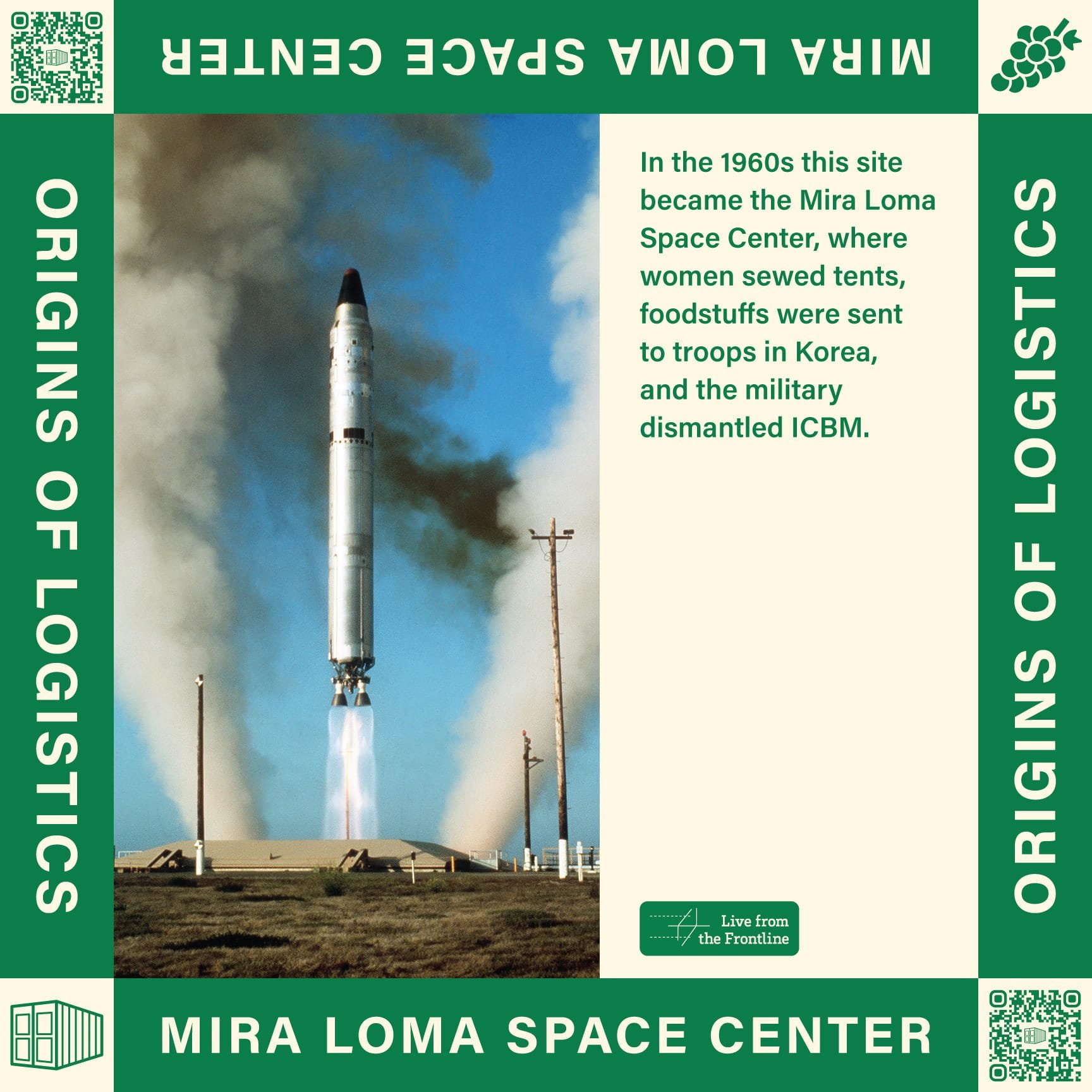Mira Loma



Mira Loma Space Center/U.S. Army Supply Depot
Space Center Ct. between 7th & Hopkins St., Mira Loma
This was ground zero for logistics in the Inland region beginning with WWII efforts to supply materials to troops and the newly opened Manzanar concentration camp. Amazon warehouses are built on the site of the former Mira Loma Space Center.
In the early 20th century, Mira Loma’s Industrial agriculture included a huge expanse of grape vineyards planted by Italian immigrants in the sandy soil. Railways enabled growers to ship their products around the country and, with nearby highways, gave Mira Loma logistical advantage during WWII, when the U.S. Army built its military supply operations here. They constructed millions of acres of warehouses to supply desert training sites and Manzanar’s over 10,000 incarcerated Japanese Americans.
After the war, this supply chain infrastructure continued to be used by military industries and then by the growing logistics sector. The Mira Loma Village subdivision was built in the 1950s to provide housing for military and civilian workers. Many Latino families who moved to the Village in later decades seeking the suburban dream are now surrounded by warehouses. Since the 1990s, their children have been studied, and their respiratory illnesses and reduced lung capacity documented in lawsuits. Still, the resulting installation of home air filters in Mira Loma Village won’t change the fact that residents here have an increased likelihood of heart attacks, cancer, and premature deaths.
From the Archives
by A People’s History of the I.E.
Click on the images below to uncover the story.
Vineyards once spanned from Mira Loma to Rancho Cucamonga, exceeding grape production anywhere in California.
Today, a few fragments of the wine industry remain in Mira Loma. Galleano Winery is a National Historic Register site whose grapes grow right alongside the loading bays for Fedex Freight. Next door is a Sam’s Club distribution center, one of the area’s many Walmart warehouses targeted in a series of labor protests that began in 2009.
Vineyards in the Guasti-Cucamonga-Mira Loma area occupied over 20,000 acres by 1917, courtesy Library of Congress
In 1942, the U.S. Army established the Mira Loma Quartermaster Supply Depot next to the Union Pacific railroad tracks, a few miles south of the Santa Fe rail line and adjacent to Mission Blvd (now I-60 freeway). The site included 9 warehouses, 11.5 million square feet of open-air storage, 12 miles of roads, and 13 miles of railroad tracks that connected the warehouses.
In an effort to recruit civilian workers and to house families of servicemen working at the Supply Depot, the Quartermaster General included an entire mini-Main Street adjacent to the complex with administrative buildings, a fire station, hospital, library, barber shop, and swimming pool.
Aerial of the Mira Loma Quartermaster Depot, 1948, HistoricAerials.com
Mira Loma Quartermaster Depot supplied all military installations in Southern California and Nevada. This included regional air bases, the Desert Training Center, Camp Haan, and Manzanar, where over 10,000 people of Japanese heritage were incarcerated during WWII.
Critics of the Mira Loma Quartermaster decried efforts to supply Manzanar’s dining halls with quality food as "un-American,” despite the fact that two thirds of the people incarcerated were U.S. citizens. Some of the supplies sent to Manzanar were purchased at cut-rate prices in Los Angeles, where Japanese grocery stores had been forced to quickly get rid of their stock. These food items soon made their way back to their intended Japanese consumers, who were now behind barbed wire.
Waiting for Lunch Outside a Mess Hall at Noon, Manzanar, July 1942, photo by Dorothea Lange, Library of Congress
Mira Loma Supply Depot struggled to find workers for their expanding operation. They relied on civilian women, who comprised 80% of the workforce, and laborers imprisoned at the Chino Institution for Men, who served as freight handlers.
Women pictured here are loading gas cans into the waiting train car.
Mira Loma Quartermaster Depot, c. 1943, Alvin P. Stauffer, Historical Section, Office of the Quartermaster General
The Depot and its Main St. continued to operate through the Korean War, until the Air Force took over in 1955. In the 1960s, the military stored decommissioned Atlas and Titan I Intercontinental Ballistic Missiles (ICBM) at the site. The property was sold in 1966 to Space Center, a private developer of industrial parks which continued its use as a logistics hub.
Former employees who worked at the Mira Loma Space Center recount sewing tents there during the Vietnam War era, welding steel, and seeing the ICBMs dismantled in the 1970s. Some believe ghosts haunt the site, a legacy, perhaps, of the Depot’s status as an “American Graves Distribution Center” during the Cold War.
Titan II, postcard, private collection.
During the 1950s, Mira Loma Village sold the suburban dream. A large development of single-family homes was planned to be built over the earlier Guasti vineyards, adjacent to the Supply Depot.
“I sure hate to see the grapes go,” longtime vineyard foreman Jack Zuniga said in 1955, “but I guess we can’t prevent progress.”
One Village tract was completed, but some of the land was sold for industrial commercial purposes. A 1987 amendment to Riverside County’s General Plan allowed huge swathes of vineyards, citrus, and dairy farms to be replaced, one after another, by “big box” distribution centers. Today the 101 homes in Mira Loma Village are surrounded on all sides by warehouses and truck traffic.
Mira Loma Village, 2017, photo by Maya Sugarman, KPCC
Protests by warehouse workers and community groups over the last few decades have brought attention to the labor and environmental costs of the growing logistics industry. Protests like WalMarch, connected struggles at Inland warehouses to those at the Port of LA. Such protests bring visibility to labor conditions across the supply chain, and, as scholar Juan de Lara writes, implicate “diesel trucks, trains, and ships in the poisoning and premature death of poor Black and Brown communities.”
Warehouse Workers United, United Farm Workers co-founder Dolores Huerta and L.A. County Federation of Labor leader (now Senator) María Elena Durazo, 2012, UFCW International CC by 2.0
In 2020, the newly formed Jurupa Valley city planning division approved the redevelopment of the Space Center by Link Logistics. The 1942 warehouses were demolished, and the redwood, Douglas Fir, and railroad ties salvaged and trucked to house builders in Montana. Today, Amazon warehouses occupy the land where the WWII buildings once stood.
“Link: The future of logistics has arrived,” 2022, photo by Catherine Gudis.
In 2021–22, Chino, Colton, Jurupa Valley, Norco, Pomona, Perris, Riverside, and San Bernardino all voted on whether or not to place moratoriums on warehouse development. Jurupa Valley’s 2021 moratorium led to a “truck intensive use ordinance” restricting high-volume trucking to specific areas, and prohibiting new truck stops and truck storage yards.
Some truckers — especially those who are owner-operators of one or two trucks — wonder why they have to bear the brunt of the policy while megacorporations can proceed unhindered. Others wonder why cities don’t rezone land to restrict industrial developments and instead zone areas for housing, which is needed, doesn’t harm neighbors, and still contributes to the municipal tax base.
Aerial of Mira Loma, 2024, photo by Eduardo Gonzales, peoplehistoryie.org
Logistics represents up to 10% of the Gross Domestic Product of the U.S., and Amazon has among the highest market value of any corporation in the world. Yet this has not translated into better jobs for the majority of workers in the Inland region. Workers at Amazon internationally have been organizing to seek better working conditions and wages. In June 2023, Amazon delivery drivers affiliated with Teamsters Local 396 demonstrated on Iberia Ave. to call upon the company to stop retaliating against workers' efforts to unionize.
“The packages matter more to Amazon right now… I delivered in a van last year in the summer. [Outside the temperature reached] 115. Inside my van, it was 130. I don't have no AC. My fucking windows that day didn't roll down.”
—Brandi Diaz, Local 396 delivery driver
2023 Strike at Mira Loma, courtesy Teamsters Local 396 and The Frontline Observer.
The Origins of Logistics
by A People’s History of the I.E.
Resources
-
CCAEJ - Center for Community Action and Environmental Justice is a community-based organization fighting for environmental justice and equity in Bloomington and throughout the I.E.
Warehouse Worker Resource Center is dedicated to improving working conditions in the warehouse industry in Southern California.
-
Boom California, “Before Amazon: Land, Labor, and Logistics in the Inland Empire of WWII” by Brinda Sarathy.
Jurupa Valley, Historic Resource Analysis of the Proposed Mira Loma Space Center.
PBS SoCal, “Slow violence of the supply chain.”
A People’s History of the I.E., “From Mira Loma to Manzanar: the Roots of Logistics” microdocumentary.
























